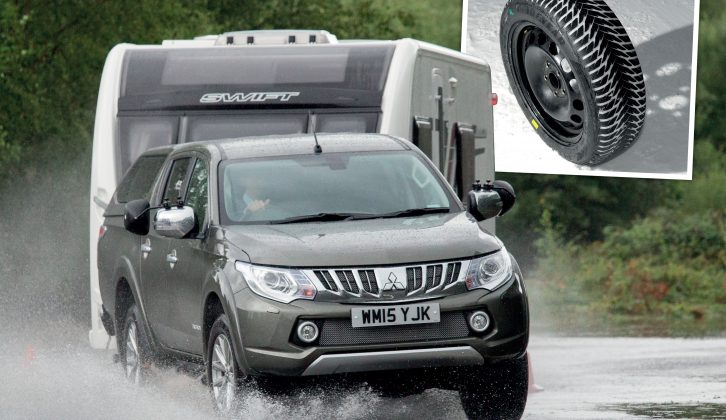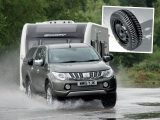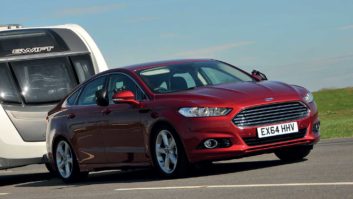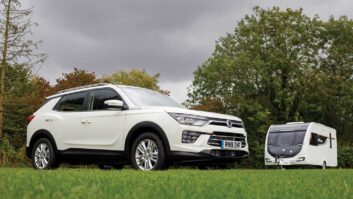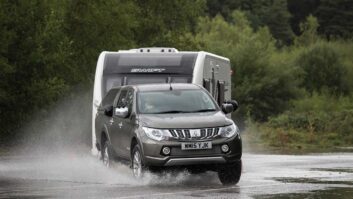It’s that time of year again. I’m not talking about the clocks going back, fireworks or the start of the Christmas countdown. I’m thinking of the switch to winter tyres.
Whether UK drivers should change to winter tyres or not has been a subject of much debate since we had a couple of harsh winters a few years back. Long periods of severe weather persuaded many drivers to make the change. But milder winters in more recent years have led many to wonder if it’s worth the expense and the hassle.
No tyre – winter or summer – will perform at its best if it’s not well cared for. That means regular checking for cuts and damage, tread depth, and the correct inflation pressure.
As the only point of contact between your car, your caravan and the road, good tyres are essential to safe caravanning not just in autumn/winter, but all year round. However, despite all of that, there can be no doubt that having the correct tyres for the conditions also has a huge part to play.
As most drivers probably understand by now, winter tyres aren’t just for use on snow and ice. They’re intended for all surface conditions in low temperatures, promising better grip once the temperature falls below 7˚C.
Back in 2011, our colleagues on What Car? put this to the test, comparing four brands of summer and winter tyres. Perhaps surprisingly, the summer tyres outperformed the winter rubber in one of the cold weather tests. Stopping from 62mph in the dry with a temperature of 5.5˚C, the summer tyres averaged a 37.9-metre stopping distance. The winter tyres needed another 5.8 metres on average, and even the best-performing winter tyre was beaten by the worst summer tyre.
However, this was the only test in which the summer tyres outshone their winter equivalents. In wet conditions – when accidents are more likely – the winter tyres stopped an average of four metres shorter than the summer tyres, this time slowing from 50mph with an average temperature of 4˚C.
On snow and ice, What Car? found a night-and-day difference between summer and winter tyres. Stopping on ice from 12mph, the summer rubber needed an extra 6.5 metres to come to a halt. That’s roughly one-and-a-half car lengths. On snow, braking from 25mph, the worst winter tyre stopped in 11 metres less than the best summer tyre.
Why are winter tyres so much better in cold, wet or snowy conditions? It’s because they are constructed differently from summer tyres and have different tread patterns.
Summer tyres harden as the temperature drops, but winter tyres use a softer compound that retains more flexibility in very cold weather. The tread pattern is designed to both clear water from the road to combat aquaplaning, and to bite effectively into a snowy surface. Extra sipes (small grooves) also help the winter tyre provide more grip on snow.
So, the belts and braces approach to safe winter driving – and towing – is to switch to winter tyres. But there’s always that question mark over whether it will be worth the expense if the winter turns out to be a mild one. The cost goes up further if you were to also change your caravan over to winter tyres, although I’ve never seen any research quantifying how beneficial this is.
Switching to winter tyres on your tow car isn’t as expensive as it might seem, though. Yes, a new set of boots could cost anywhere from £250-£700 or so, but you’ll be saving wear on your summer tyres when running winter rubber and vice-versa. So paying for winter tyres now will delay the next time you need to shell out for replacement summer tyres.
Storing summer tyres over winter isn’t necessarily as much hassle as it first seems, either. Many dealer networks offer ‘tyre hotel’ services, with prices ranging from approximately £70 to £125 depending on the car brand and the length of stay.
Despite the evidence in favour of winter tyres, and the services which reduce the hassle of switching, most UK drivers still stay on summer tyres all-year round. Some might argue, given our relatively mild climate compared with Scandinavian countries or mountainous parts of Europe, we’d be better off running all-season tyres instead.
For my part, I’ve always been a bit suspicious of tyres designed to work well all-year round. Certainly when I’ve tested tow cars fitted with all-season rubber they haven’t shone in the lane-change test that we do as part of our tow car reviews, with an imprecise feel and modest grip compared with summer tyres.
However, new types of all-round tyres have come to market recently which promise better performance. One is the Michelin CrossClimate. Michelin doesn’t describe this as an all-season tyre, preferring to market it as a ‘summer tyre which can be used in winter conditions’. In other words, it is certified for use as a winter tyre, but optimised for summer driving.
The ADAC (the German equivalent of the AA) tested the CrossClimate against all-season tyres and found it outperformed them in the dry and the wet. It scored respectably on icy roads, and only underperformed on snow. It emerged the overall winner of the ADAC’s tests.
So, still a compromise of sorts, but perhaps a more sensible one for typical UK conditions than running conventional summer tyres all-year round.
Why are winter tyres so much better in cold, wet or snowy conditions?
